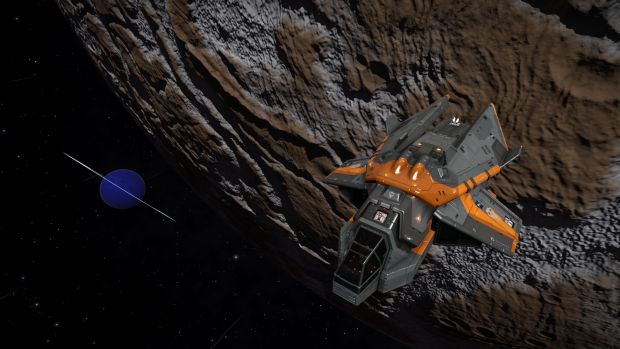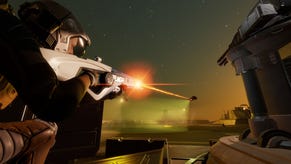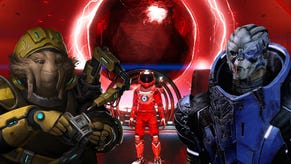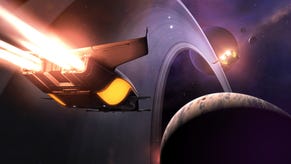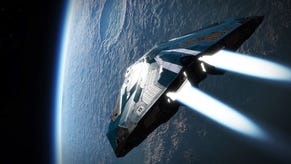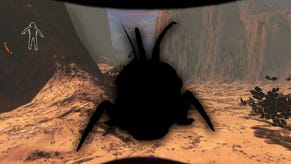Ridealong: The Flotilla That Will Cross The Galaxy
Visiting the galactic abyss
900 pilots in Elite: Dangerous have banded together to undertake a three month expedition to the far side of the galaxy. But such a long journey into deep space has its dangers. Breakdowns, accidents, fuel shortages and even player-led pirate gangs will mean many of the pilots won't make it. In this Ridealong, I met up with the organisers on the day of departure to witness the huge fleet launch into the deep unknown.
It's six hours until departure and I'm flying around a backwater space station called Zillig City, idly piloting my new ship. When I nearly crash into the station by accident, I'm warned about loitering and quickly boost away. I don't want to revive my criminal record.
"Do you know what," says Dr Kaii, over the radio, "you can easily get any bounty you want. Because after this trip they will all expire. Twelve weeks is great, I might just go on a killing spree and be completely absolved."
I laugh. Dr Kaii is one of the organisers of Elite's most ambitious player-led expeditions so far. He has put the trip together in partnership with Commander Erimus, a famous explorer among the players. Although the Doctor talks of getting a bounty, I find it difficult to imagine him waging war. He has the kindest voice and most polite manner of any hardened spacer I know. I think he is joking about the murder spree.
"Yeah, I mean, if you murder someone, you are basically in trouble for a week but if you can evade capture then nobody cares anymore. That's the great beautiful world of Elite: Dangerous."
There will be plenty of time for the lawmen to forget about the exploits of any renegades taking part in the expedition. The whole trip is estimated to take three months - and that's just the outward journey. Officially, the expedition ends when the flotilla (or what's left of the flotilla) reaches Beagle Point, a distant system on the farthest spiral arm from Sol (here's a map of the journey plan to give you some idea of the distance). After that, the explorers are free to go wherever they want. Many will stay and explore the virgin systems of the far reaches. Some will simply head back to the "bubble" - the tiny region of space inhabited by humanity and populated with stations like Zillig City.
"What happens when we get there is not an official thing. Basically that's the end of the official expedition. Erimus wants people to stay there and look around but that's entirely optional. We want to try and map out the area as a group, we can get a lot more done as a group. I'm personally probably going to head back at full speed because I really will be missing the bubble at that point.
"That's my main hesitation at the moment. I'm actually quite nervous to go on this trip because it's so long. Can you imagine? Four months. Three months getting there and I'm gonna come back in around a month. And I really, really will miss all my ships, I'll miss the stations..."
We decide to go to the Pallaeni system, where the expedition is taking off at 8pm this evening, to see if anyone is gathering yet. Erimus tells the Doctor over comms that he has just accidentally collided with a police vessel and taken 9% hull damage. "A great start to the expedition," he says.
Erimus himself has already done this trip three times in his ship the DSS Beagle (Beagle Point, the final destination, is named after his first journey). This makes him one of the most prolific trailblazers in the game. Dr Kaii hasn't gone further than Sagittarius A, the system in the centre of our galaxy that houses the supermassive black hole he describes as "the anchor of the galaxy". But even this is an incredibly long journey to undertake. He says it is worth it to see the "anchor".
"It's basically the same as every other black hole except it's huge. And you can perceive that by the way it distorts the world around it. But it's not dangerous, it's just stunning. And it feels very good to arrive there."
But can you even get a sense of the scale of it?
"Yes, you can. Because it does manifest differently, unlike stars. The large stars and small stars basically look the same because of the distance you can get to them. Sagittarius A is different from other black holes. It definitely feels bigger and you can get a lot closer to the event horizon."
We arrive in Pallaeni and head towards the planet where the flotilla will be gathering. There are people on the surface already, ships settled at a base camp near one of the planet's manned facilities. The planet itself is misshapen and lumpy - it looks more like a potato than a sphere. I pull into the wake of the DSS Beagle and begin an orbital descent, following Erimus, ever the trailblazer, to base camp.
I haven't done many of these planetary landings but the planet's low gravity (it is about 0.02 the mass of earth) means I am unlikely to crash. My ship pulls out of orbit and enters the "gliding" phase, which is effectively a superfast free fall. It is the most worrying part of landing. As the ground rushes towards me, all the fine details of the surface spring up. At this point you are supposed to glide as far down as possible, so you get to the ground faster. But I pull up and abort the glide 30km above the surface, just to be on the safe side. I start trundling toward the camp. Erimus and the Doctor are already on the ground.
When I get closer to the surface I see three black diamonds come into focus. They are Anacondas parked in the camp. It isn't long before one of them is balancing on its nose, doing a handstand against the dusty surface.
"This is part of the fun that's going to ensue on this trip," says the Doctor. "People are just mucking about. I'm going to do a flip. Are you near here? Because you can watch me. I'm gonna do a flip."
But we aren't in the same instance. Elite's multiplayer netcode strikes again. It takes us a few minutes to get reunited and when I arrive back the amount of ships on the surface has increased. It is 5 hours until the expedition is scheduled to officially depart, yet more than a hundred people in the group are already online, dozens of them gathering at this basecamp. I fly low, circling the ships gathered on the planet. There are massive Anacondas, bulky Asps, even a sleek, giant Imperial Clipper joins eventually. A few of the commanders are out in their moon buggies, frolicking on the rocky surface. The local chat channel is beginning to liven up.
"Look at that cute Diamondback," says one of the commanders. It takes a moment for me to realise they mean me. My new ship is a Diamondback. It is about a quarter the size of the next biggest ship in this ad hoc parking lot.
But that doesn't worry me. I will only be travelling with the group to the first waypoint on the journey, to an area known as the Fine Ring Sector, a region of space where a small purple gas cloud hangs nearby. This cloud is the nebula of a system called Shapley 1 and from earth it looks like a tiny ring of smoke. But from the basecamp they have set up out there, it reportedly looks like a the sky has a black eye. The basecamp itself is called "Laika's Rest" a much more memorable name for the first planetary stop-off than its official astronomical designation (Fine Ring Sector JH-V C2-4, planet A1). Although Laika's Rest is about 1000 lightyears into unknown space, it is nothing compared to the 81,500 lightyears the fleet will be travel before eventually reaching their destination. I am essentially walking the flotilla to the door.
To give you some sense of just how little of the trip I will be taking part in, here is the distance between the launch system and the first waypoint at Shapley 1, when you examine it closely on the game's map:
The red symbols on the left are the in the bubble, the green symbols to the far right are fellow travellers at the first waypoint. Now, here is the distance between the two on a galactic scale:
Waypoints like this have been established to make things easier for the pilots. They will meet at camps on planetary surfaces like Laika's Rest to catch up with other pilots for a day or two. Then head on their way. Exploring has always been a boring occupation in Elite because of the long periods without stations or human activity. The Doctor and Erimus are hoping that keeping people more or less together and having these small gatherings will keep spirits up. And thinking about it this way, seeing the circle of ships at the Pallaeni base camp reminds me of sitting at a bonfire in Dark Souls. The pilots are isolated out here, but they are also together.
"Boredem is quite a weak word for what I'm expecting it to feel like," says Kaii. "It's more like complete tedium. It's going to be very important to break it up. That's why we've got all these waypoints along the way that are incredible locations, getting out in the buggy, bombing about. You can do like 100, 150, 200 jumps maybe and then take a nice break at the waypoints. That's basically how you have to do it. Not all of us have the patience and fortitude of Erimus, who can do that trip in the space of a month."
The Doctor and I are messing about on the surface, driving around in the space buggies from Elite's newest expansion. He revs up his buggy's thrusters and leaps from a mound of dirt, doing a flip in the low gravity. I would attempt a stunt of my own but I have learned the hard way not to try and emulate the maneuvers of professional pilots.
On page two, what it takes to prepare for such a long journey, and the risks that face the pilots along the way.
More pilots come and go as the day wears on, probably making final alterations to their ships while they are still in the bubble. Once they've departed, there will be no stations, no pitstops, to change the loadout of their ships.
The Doctor is incredibly proud of the organisation that it has taken to put this trip together. About 900 players are now on the expedition roster, many of them adopting voluntary roles as cartographers, prospectors, film makers, photographers, cargo haulers, armed escorts and "fuel rats". The latter role is an important one, since it involves rescuing ships stranded far from the stars they need to use as refuelling points. The fuel rats can refuel an empty tank with drones brought along especially for this purpose. Stranded pilots will have to broadcast their location on the group's emergency channel and power down all non-essential systems while waiting for rescue, to conserve whatever small amount of juice they have left. That's when any nearby rats will come scurrying to help.
But this is not the only thing that will threaten the explorers. A big problem for the group is unexpected ship damage. Emergency stops from supercruise (Elite's version of warp) will cause low amounts of damage to the hull. And overheating, either in the glare of a nearby sun or from your own ship's systems, can damage your modules. Everything from your engine to power distribution to life support is vulnerable. In the bubble, you can shake this off. Just pop into a station and get some repairs. But out in the wild void even small amounts of damage are cause for concern because they can accumulate over time, shaving the health off your vessel, without hope of repair. One commander, whose hull took just 3% damage due to "an unfortunate over-acceleration into some pretty rings around a brown dwarf", told the group that if his hull is 50% or lower by the time he hits the galactic centre, he is turning right back.
Is the Doctor worried about losing people like this along the way?
"Of course, we are definitely going to lose some people. There's plenty of mishaps that can happen. I think a pirate attack would make headlines and I think it would be really interesting, although I wouldn't wish it on anyone."
Is that likely to happen? Elite's NPC pirates don't operate beyond a few hundred lightyears outside the bubble.
"Yeah, that's true. That's NPC pilots. But there could be some stowaway player pilots from private groups and there's nothing we can do about that."
So he is worried about other players? People following the expedition out into the unknown, to hound them?
"Yeah. Exactly... There's been people talking on forums and other websites about really wanting to infiltrate the group and cause some damage. But we've done our very best. We've been very strict about who gets into the private group. I'm basically acting as security co-ordinator. I'm not actually security but anyone who files a report that they've been attacked or have any kind of problem like that, I can get the names and kick them from the group.
"I know that's very 'anti' the spirit of Elite but this trip is about getting to the other side. We don't want players coming along and just messing it up for the fun of it."
The Doctor's fears would prove to be true. Two days into the journey his trailblazing partner, Commander Erimus, will broadcast a message on the fleet's emergency Skype channel, telling pilots to be wary of a trio of hostile player ships in a black hole system that a lot of the explorers were hoping to treat as an excursion along the way.
"[Unconfirmed]," the message starts. "Warning for pilots heading out to the Lagoon Waypoint early, a pirate wing has been reported at Thor's Eye. Those in open play beware."
You can understand the flotilla's wariness. The pilot who discovered the bandit trio (and who was subsequently chased) said: "I got away at 93% - how I managed that I have no idea." If the pilot had been destroyed, all the exploration data collected so far on that ship would have been lost. And they would be taken back to the last station where their ship was docked. All the way back to the bubble. If this is a severe inconvenience in the first 4000 lightyears of the trip, imagine how heartbreaking it would be one or two months into deep space.
Yet, out there in the black, there are some things more deadly than pirates.
"The worst case scenario is bugs," says the Doctor. "There's a bug going around where the SRVs [space buggies] blow up, just randomly. If that happens to me twice, I've got no SRVs. And if the game bugs in some way that means I'll have to go all the way back to the bubble, that'll be very annoying. That's the worst case scenario. To be honest space is pretty safe, if you know what you're doing. Even if you crash into 8 stars, you should be fine. It's only when you start crashing into ten or eleven.
"Oh! Worst case scenario as well - underestimating the gravity pull of a planet... as you start getting closer to the ground you might not realise how fast you're going and if you try to pull up it won't work. And if, for example, your landing gear is out, or if you have forgotten to put pips [power] into engines, then you could end up not being able to boost your way out of that.
"And if its a really bad planet - I've never even tried 3 or 4 or 5 G - it could be that even a boost can't help you there. It's very, very easy to not quite realise. You're just going down and you think you're in control and as soon as you try to pull up, you realise you're not in control... that's the worst thing."
As if pirates, gravity wells, stars and bugs were not enough of a problem, the Doctor anticipates basic human error will be a major killer among the pilots.
"The thing that's giving me the most trepidation is the length of it... It's very easy to get fatigued and start being sloppy. And sloppiness is an explorer's worst nightmare because you do things like crash into planets, you do things like overheat, you do things like leave silent running on by mistake and not realise. All those sorts of things.
"I reckon a good 10% of people are going to not make it because of some mistake like that, including me probably. But I'm going to do my best."
The Doctor gets back into his ship and floats above my buggy in his Asp. He tells me he is going to "brighten my day" then lowers the hulking ship face-first toward me. He hangs just 10 metres above my fragile buggy, and all I can think of is how I would be cracked like a nut if he pressed even a little closer.
I will see more hijinks like this from explorers - stacking Anaconda's one on top of the other, buzzing each other, boosting a buggy onto a Cobra and driving around on top of it. It's a playfulness between pilots I have never really seen before in the game, but it is also recognisably the behaviour of self-exiled frontiersmen, just trying to keep themselves occupied in the dark regions of space in whatever way they can.
It's time for Dr Kaii and I to part ways. In a few hours, he will lead the countdown to the expedition's launch live on Twitch. I will tune in to watch the Doctor as he lists the pilots who have helped bring it all together. Then: 3, 2, 1.
The ships take off from the base camp and trail into the sky. One of the Anacondas has trouble and begins falling. It looks like engine trouble, or a throttle problem. It falls back and slams its backside onto the surface again. For a moment I fear an explosion of Cape Canaveral style horror. But the Anaconda stays together, the pilot quickly recovers and takes off again. Then Dr Kaii, who until now has been filming the departure, powers up his engines and boosts into the sky. The expedition is under way.
I plot a course for the Fine Ring Sector and follow the flotilla. I have to see them to the door, after all. Pilots in systems along the way salute to me in local chat and I salute back. Little broadcasts of "o7" coming through on the comms.
It takes about an hour and a half for me to reach "Laika's Rest". The base camp is settled inside a crater within a crater, from an impact so big it has left trails across almost one half of the entire surface. An easy camp to spot.
Ships stream into the system and head for the rest stop, their white wakes gleaming all around the planet. On the surface, a hill raises out of the centre of the crater, the focal point of the camp. Some pilots have perched on top, others have made a circle on the crater bed. The buggies are back out, frolicking again.
In 80,000 lightyears these pilots (those that make it) will encounter "the Abyss" - a dark region of space where the stars are far apart, on a sparse spiral arm of the galaxy. If I was to attempt a crossing of the Abyss in my "cute" Diamondback, with its 26 lightyear jump range, I would be unable to make the last hops, because the stars are so distant from one another. But those that do make it in their bigger ships will be afforded a view that would make lesser pilots go mad. They will stand on the edge of the galaxy, look out, and see nothing.
Blackness. No stars, no nebulae. If they are lucky, a few distant galaxies might be the only things visible in a huge void. It's scary to think how dark those pilots' eyes will be, looking out at that nothingness.
But then again, they can simply turn around.












